Overview
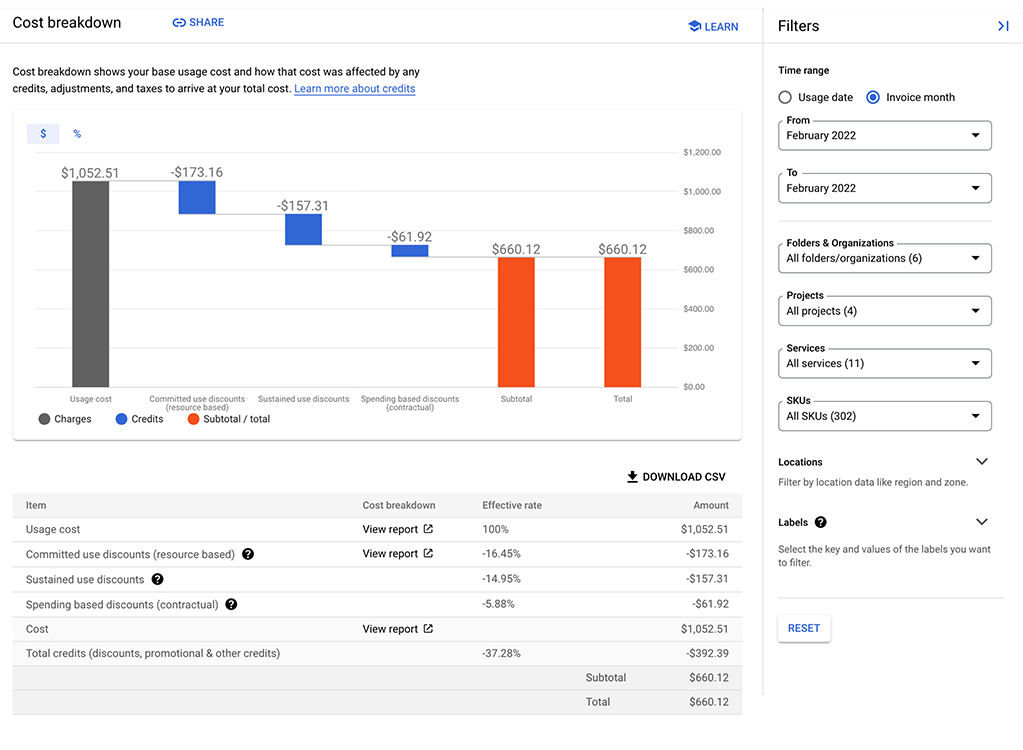

For the selected date range and filters, the Cost breakdown report shows your base usage cost (calculated from on-demand prices) and how discounts, credits, adjustments, and taxes affect this cost to arrive at your total.
The waterfall chart displays Charges in orange, Credits in green, and Subtotals and Totals in blue.
Permissions required to access the cost breakdown report
To view the cost breakdown report for your Cloud Billing account, you need a role that includes the following permission on your Cloud Billing account:
billing.accounts.getSpendingInformationto view costs and usage for a billing account.
To gain this permission using a predefined role, ask your administrator to grant you one of the following Cloud Billing IAM roles on your Cloud Billing account:
- Billing Account Administrator
- Billing Account Costs Manager
- Billing Account Viewer
For more information about billing permissions, see:
- Overview of Cloud Billing access control
- Create custom roles for Cloud Billing
- Understanding predefined IAM roles for Cloud Billing
Access the report
To view the Cost breakdown report for your Cloud Billing account:
In the Google Cloud console, go to your Cloud Billing account.
At the prompt, choose the Cloud Billing account for which you'd like to view reports. The Billing Overview page opens for the selected billing account.
In the Cost management section of the Billing navigation menu, select Cost breakdown.
How to read the cost breakdown chart
From left to right, the chart displays bars for charges, then credits, then subtotal, then any invoice-level charges, and then total, aggregated for all costs incurred during the selected time range.
The first bar on the chart is the gross cost of your usage, which represents the amount that you would've paid during the selected time range if you were charged only at the on-demand rate for your Google Cloud usage. Then, the report shows you how much you saved, broken out by savings types (for example, committed use discounts and sustained use discounts). Finally, if your time range is configured for invoice month, the report shows your invoice-level charges such as tax and adjustments (if any) applied for the selected invoice months.
If your Cloud Billing account is associated with a custom pricing contract, the on-demand rate used to calculate the gross cost of your usage depends on the time range of the costs you're analyzing:
- For costs incurred before May 1, 2021, your on-demand rate is based on your contract prices, and includes the savings you earned compared to list prices.
- For costs incurred after May 1, 2021, your on-demand rate is based on the publicly available list prices. The savings you earn with your custom contract prices (compared to list prices) is displayed on the report as a negotiated savings credit.
Below the chart is a summary table of the information in the report. The summary table includes a row for each bar on the chart, displays the effective % rates of costs and savings, and provides links to open related report pages where you can view the details behind specific cost breakdown report values.
| Examples | |
|---|---|
For a Cloud Billing account associated with
standard list prices (and for any billing account viewing costs
incurred prior to May 1, 2021), the cost breakdown report displays a
Usage cost column, along with any applicable credits and
invoice-level charges:


|
For a Cloud Billing account associated with a
custom pricing contract, when viewing the report using a time
range that starts May 1, 2021, or later, the cost breakdown report
displays a **Usage cost** column, and a
Negotiated savings column, as well as any other applicable
credits and invoice-level charges:
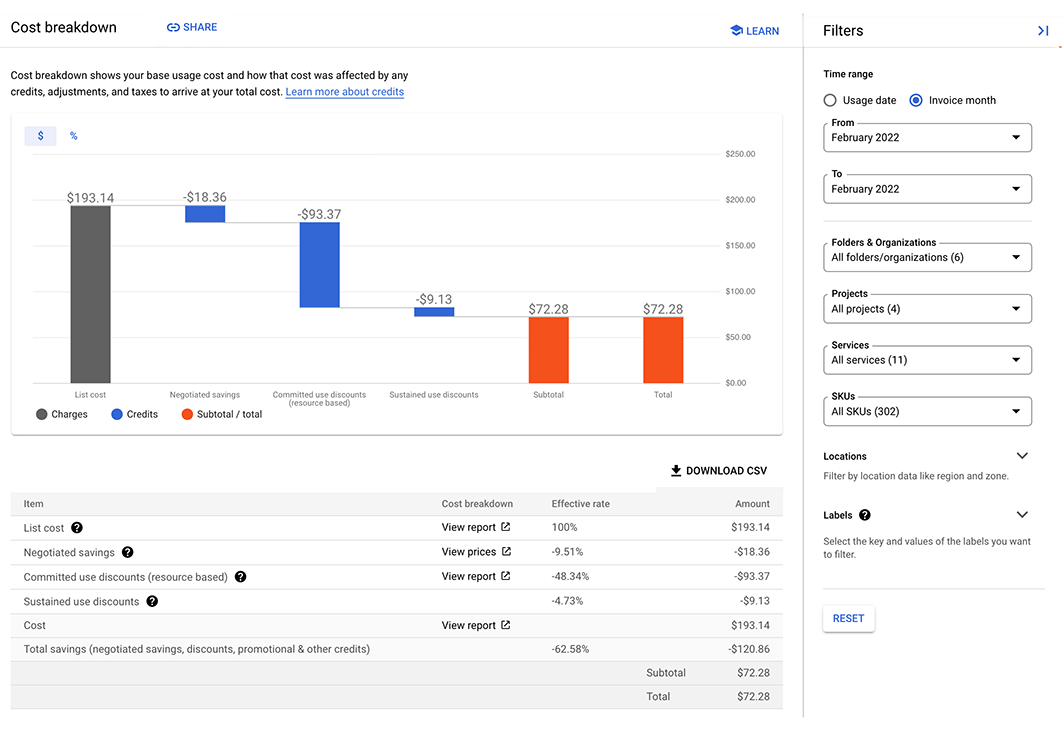

|
About on-demand rates
Each Cloud Billing account is associated with a price list, which provides the prices per SKU for your usage of Google Cloud Platform services, Google Maps Platform, and Google Workspace.
- If your Cloud Billing account is using standard list prices, your on-demand rates are based on the publicly available price list.
If your Cloud Billing account is associated with a custom pricing contract, your on-demand rates are based on your custom price list.
- On the cost breakdown report, when viewing the report using a time range that starts before May 1, 2021, the gross cost of your usage is calculated using your custom contract prices.
- When viewing the report using a time range that starts after May 1, 2021, the gross cost of your usage is calculated using list prices.
To view your prices per SKU for your Cloud Billing account, see the Pricing table report or export your Cloud Billing prices to BigQuery. If you have questions regarding pricing, contact your Account Representative for more details.
Configure your report settings
You can select the costs you want to analyze and configure the display of your cost breakdown report using the Time range and other filters. As you configure the report, your page URL updates to include your selections; use Share to copy the URL to share the report. Click the Download CSV selector located above the summary table to download the filtered cost breakdown data.
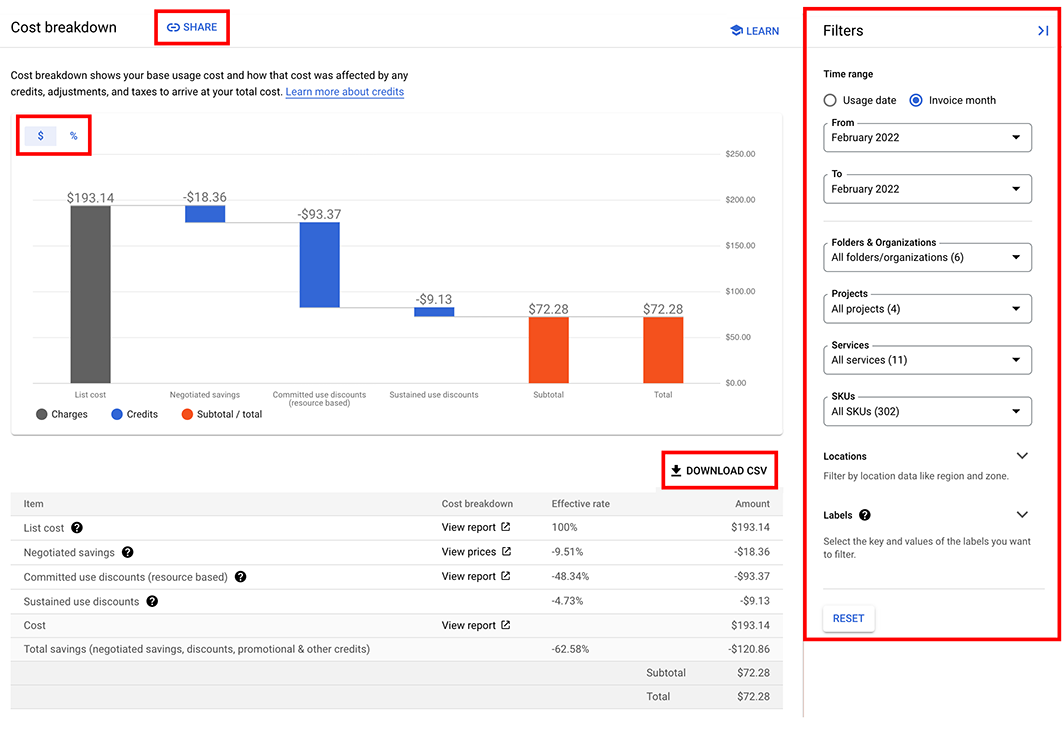
Time range
Set the range of time for the usage costs you want to analyze. You can select between Usage date or Invoice month. By default, when you first access the report, the Time range is set to Invoice month, with the most recent complete month selected.
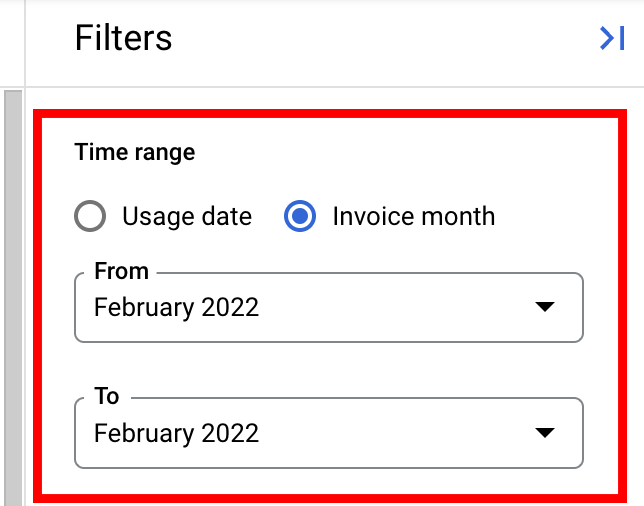
Usage date returns actual usage and cost data incurred during the date range selected. When you select Usage date, you can choose a preset or custom time range for charting your cost data (available back to January 2017).
When you set a usage date time range, the cost breakdown report doesn't display invoice-level charges, such as tax, contractual credits, surcharges, or adjustments.
Invoice month returns usage and charges on the invoices issued for the months selected. When you select Invoice month, you can set a range based on complete months (available back to May 2019).
When you set an invoice month time range, the cost breakdown report includes invoice-level charges, such as tax, contractual credits, surcharges, or adjustments.
If your Cloud Billing account is associated with a custom pricing contract, the on-demand rate used to calculate the gross cost of your usage depends on the Time range of the costs you are analyzing:
- When viewing the report using a time range that starts before May 1, 2021, the gross cost of your usage is calculated using your custom contract prices, and includes the savings you earned compared to list prices. On the report, these charges are displayed in the Usage cost bar.
- When viewing the report using a time range that starts after May 1, 2021, the gross cost of your usage is calculated using publicly available list prices. On the report, these charges are displayed in the Usage cost bar. Additionally, the savings you earn with your custom contract prices (compared to list prices) is displayed on the report as a Negotiated savings credit.
Filters
The Cost breakdown report can show all charges and credits for the entire Cloud Billing account, or you can filter it to focus on a specific set of resources. By default, when you first access the report, the filters are configured to include all values. As you set your filters, the amounts displayed in the report adjust to represent the aggregated charges and credits based on the filters selected.
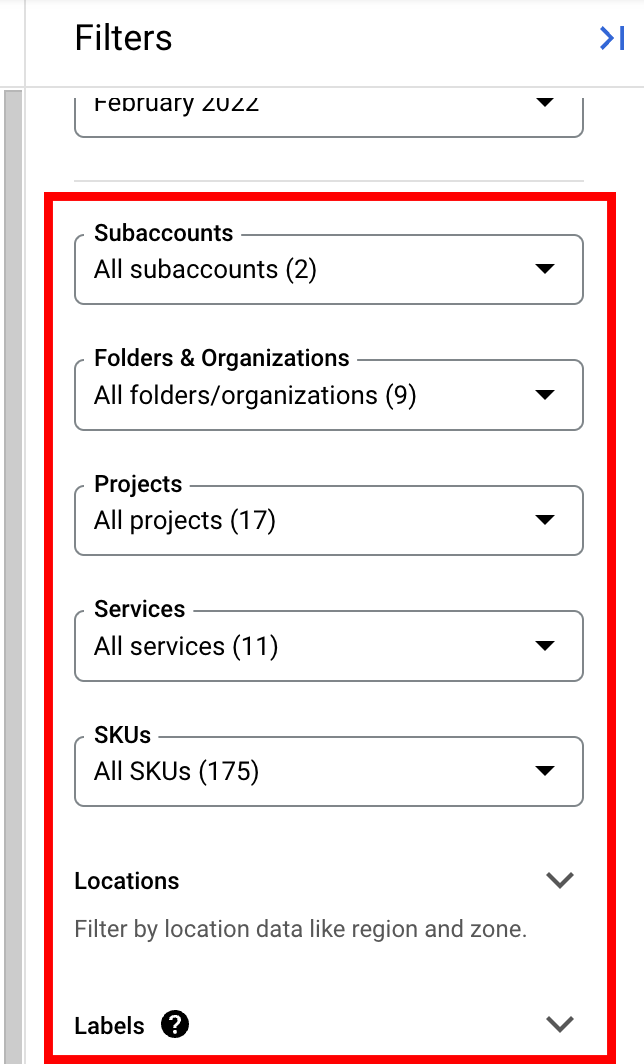
Subaccounts: If you're viewing a primary billing account with subaccounts, you can select all subaccounts (default) or select a subset of subaccounts by clicking them in the list.
Folders & Organizations: Folders and organizations are components of a project hierarchy, the resource hierarchy mapping of a project. If the Time range is configured to start on or after January 1, 2022, you can select all folders and organizations (default) that are associated with the projects that are linked to the Cloud Billing account, or select a subset of folders and organizations.
The values in the selector are listed in alphabetical order by resource name. To determine if a value is an organization or a folder, look at the ID number following each name. ID numbers are prefaced with folders/ or organizations/ to indicate the type of resource.
For the Cloud Billing account you're viewing, if none of the linked projects are associated with any folders or organizations, then this filter option isn't displayed. To learn more about organizations, folders, and project hierarchy, see Billing reports: Analyzing your costs by project hierarchy.
Projects: You can select all Google Cloud projects under the Cloud Billing account (default) or select a subset of projects by clicking them in the list.
Services: You can select all services (default) or select a subset of services by clicking them in the list.
SKUs: You can select all SKUs (default) or select a subset of SKUs by clicking them in the list. To learn more about SKUs, see the pricing table report.
Applications: You can select all App Hub applications (default) or select a subset of applications by clicking them in the list.
App Hub applications might incur usage and costs in more than one billing account and associated projects. Cost data filtered by application might be based on partial data, limited to projects and costs for the Cloud Billing account you are actively viewing.
To filter on costs that are not part of an App Hub application, select [Charges not specific to an application].
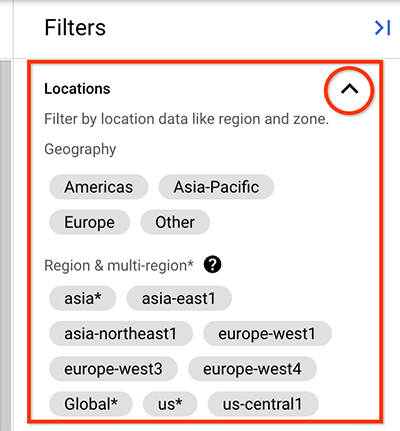
Locations: By default, all locations are enabled. By clicking the location tiles, you can filter on a subset of locations by geography (such as Europe), multi-region (such as Global), or region (such as us-east1). Specifically, the report is filtered by the regions and multi-regions selected.
Use the tiles in geography to quickly select (or deselect) all regions and multi-regions in that geography. Multi-regions tiles are marked with an asterisk (for example,
us*).Learn more about geography and regions.

Labels: Labels are key/value pairs you attach to resource usage (for example, Compute Engine or Cloud Storage). To filter usage by label:
- Expand the Labels section.
- Select the label Key.
- Select the Value under that key you want to filter on (the default is all values under the selected key).
To add another label with a different key, click + Add Label, and then select the key and values for the label filter.
To remove a label filter, click (delete) for each label key-value pair that you want to remove.
If you want to view costs for Google Kubernetes Engine, you can filter your resources using the following label keys:
goog-fleet-project: Filter cluster resources by fleet host project, if the cluster is registered to a fleet.goog-k8s-cluster-location: Filter GKE resources by location.goog-k8s-cluster-name: Filter GKE resources by cluster.goog-k8s-node-pool-name: Filter cluster resources by node pool.
To filter GKE resources using the following label keys, you must enable cost allocation for your GKE clusters:
k8s-namespace: Filter GKE resources by namespace.k8s-namespace-labels: Filter GKE resources by fleet namespace label.
When filtering by label keys, you can't select labels applied to a project. You can select other user-created labels that you set up and applied to Google Cloud services. For more information about labels, see common uses of labels and creating and managing resource labels.
Chart unit
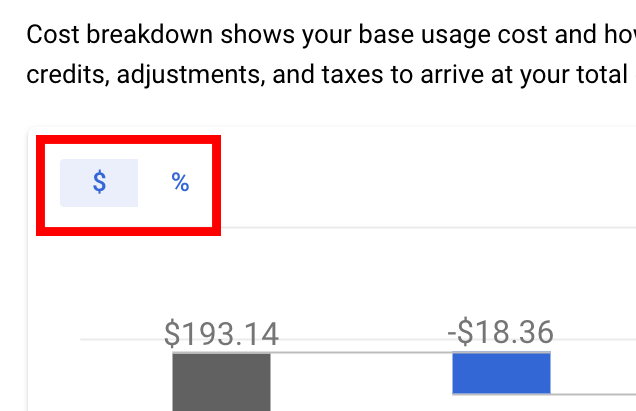
The chart unit setting is located above the bar chart and controls the value unit for the amounts displayed in the bar chart. By default, when you first access the report, the chart unit is configured to display the values in currency. You can toggle the chart units between currency ($) and percent (%) by selecting the preferred option.
The $ icon represents the currency setting for the chart unit option. The actual type of currency that's used to calculate your costs matches the currency of your Cloud Billing account. When viewing the values in the bar chart using currency, the amounts of charges, credits, and subtotals and totals are prefaced with the symbol for the currency of your Cloud Billing account (for example, USD: $, GBP: £, EUR: €, or JPY: ¥).
Understand the values in the chart and report summary
The cost breakdown chart shows the following, if applicable to your Cloud Billing account. If you don't incur these types of charges or credits, you won't see these items on your report.
Charges
Usage cost: The monthly cost of your cloud usage calculated using the on-demand rates in effect for your Cloud Billing account.
CUDs fees in Usage costs:
- For previously purchased Legacy spend-based CUDs and Resource-based CUDs, the Usage cost amount includes the fees for any committed use discounts (CUDs) you purchased, and before any credits are applied.
- For the new Spend-based CUDs program, the fee to purchase spend-based CUD discounts is excluded from the Usage cost amount. Instead, the spend-based CUD discounts fee is included in the net calculation of the Spend-based CUD discounts credit amount.
Credits
The following savings, discounts, and credits appear on the report if applicable to your Cloud Billing account and selected Time range:
Negotiated savings: A credit that displays for Cloud Billing accounts associated with a custom pricing contract. The Negotiated savings amount represents your cost savings computed using this equation:
Negotiated savings = Costs at Contract price - Costs at List priceNegotiated savings is available when using a starting Time range set to May 1, 2021, or later.
Note that for Cloud Billing accounts associated with a custom pricing contract, when you configure the report using a starting Time range set prior to May 1, 2021, the Negotiated savings bar isn't displayed. In these instances, the Usage cost bar is displayed, which shows the gross cost of your cloud usage calculated using your contract prices.
Spend-based CUD discounts: This is the net impact of the new spend-based commitments, which includes the fees paid for your spend-based CUDs as well as the discounts earned based on your consumption model. When your commitments are fully utilized, this bar appears as a green credits bar. If your commitments are underutilized, this bar can appear as an orange charge bar, representing wasted usage.
Legacy spend-based CUD credits: For spend-based committed use discounts (CUDs) that aren't part of the new pricing model, this is the credit earned in exchange for your commitment to spend a minimum amount for a service in a particular region. Learn more about spend-based committed use discounts.
To analyze the details and the effectiveness of the CUDs that you purchased, view the CUD analysis reports.
Resource-based CUD credits: Compute Engine lets you purchase committed use contracts in return for deeply discounted prices for VM usage. This is the gross savings you realized from your Compute Engine commitments. Learn more about resource-based committed use discounts.
To analyze the details and the effectiveness of the CUDs that you purchased, view the CUD analysis reports.
Free tier usage: Some products offer free resource usage up to specified limits. For some services, credits are applied to implement the free tier usage. Learn more about free tiers.
Promotional credits: The total savings you received from promotional credits, such as spend-based milestone credits, Google Cloud Free Trial, and marketing campaign credits, or other grants to use Google Cloud.
Sustained use discounts (Compute Engine): This credit represents the automatic savings you receive for running eligible Compute Engine instances for a significant portion of the month, with no commitment required. Learn more about sustained use discounts.
Reseller margin: For resellers only, this is the Reseller Program Discount credit you receive for selling eligible Google Cloud products.
Spending-based discounts: The total savings you earned for the time period you're viewing. Spending-based discounts offer progressively larger discounts based on your total spend over a defined period, or discounts that are applied after a contractual spending threshold is reached.
Subscription credits: The total savings you earned from long-term subscriptions to services that are purchased in exchange for discounts. These credits are typically applied to Base + Overage subscriptions, also known as Non-Unified Commitment Service (Non-UCS) subscriptions.
Others: Other credits or discounts that aren't associated with the current categories.
See Cloud Billing Reports to learn more about savings and credits.
Invoice-level charges
Invoice-level charges are generated when an invoice is issued and are only displayed in the report when you're viewing your costs by Invoice month. When you set a Usage date time range, the cost breakdown report doesn't display invoice-level charges. When you set an Invoice month time range, the Cost breakdown report includes invoice-level charges, if applicable to your Cloud Billing account.
- Adjustments: The total of any adjustments that were applied to your invoices (if applicable), for the selected invoice months. Adjustments are credits or surcharges applied to your Cloud Billing account due to billing corrections and contractual requirements. An adjustment might be issued in a different month than it's applied. For guidance on analyzing adjustments, see Understand memos and adjustments.
- Tax: The taxes that applied to your usage for the selected invoice months, for each tax type.
Learn more about invoice-level charges:
- See the Cost Table report for a detailed, tabular view of your monthly costs for a given invoice or statement (by invoice month and document number).
- See Cloud Billing Reports for an at-a-glance report view of charges by invoice month, including invoice-level charges.
- View your Cloud Billing documents to see all your invoices and other documents issued to your account. Open the document to see account balance details and where credit or debit memos are applied.
Report summary
Below the chart is a summary table of the information in the chart. The summary table includes a row for each bar on the chart, and displays the effective % rates of charges and credits.
- When you hold your pointer over a row in the summary table, the corresponding bar in the preceding chart is emphasized.
Click the View report links to open the corresponding report pages where you can view the details behind specific cost breakdown report values.
Links to the Reports page open the report with the same filters you set here.
- The Usage cost row shows gross costs. The View report link in the Usage cost row opens a report excluding all Savings options in the Report's filter settings.
- The View report link in the Cost row opens a report including all Savings options in the Report's filter settings.
Not on the chart
The following is not shown on the cost breakdown chart:
- Cost breakdown by individual invoice: Typically, one invoice is issued per month, per Cloud Billing account, but it's possible to receive more than one invoice in a month. The cost breakdown chart aggregates the costs and credits for all invoices issued during the selected invoice months. You can't view the breakdown report for an individual invoice.
- BigQuery flat rate savings: The cost of BigQuery flat rate is included in the Usage cost bar; we don't separate the savings you achieved from purchasing BigQuery flat rate.
- Cloud Storage Growth plan: The cost of Cloud Storage is included in the Usage cost bar; we don't separate the savings you achieved from purchasing the Cloud Storage Growth plan.
- Promotional or custom pricing: For Cloud Billing accounts associated with a custom pricing contract, when viewing cost incurred using a starting time range before May 1, 2021, the cost of resources in the Usage cost bar is calculated using your contract prices. To view your prices per SKU, see the Pricing table report or export your Cloud Billing prices to BigQuery. If you have questions regarding pricing, contact your Account Representative for more details.
- Project hierarchy filter options: When viewing cost incurred using a starting time range before January 1, 2022, the Folders & Organizations filter selector is inactive. For the Cloud Billing account you're viewing, if none of the linked projects are associated with any folders or organizations, then the Folders & Organizations filter isn't shown. To learn more about organizations, folders, and project hierarchy, see Billing reports: Analyzing your costs by project hierarchy.
Share or bookmark the URL of a customized report
You can bookmark or share the URL of a Cost breakdown report you've customized. As you configure your cost breakdown report by setting the time range and filters, your page URL updates to include your selections.
- You can share the report by copying the URL. Click Share to copy the URL to your clipboard.
Optionally, in your browser, you can bookmark the URL to save the URL with your report settings.
Download cost breakdown data to a CSV file
You can download the cost breakdown data to a comma-separated values (CSV) file using the Download CSV selector located above the summary table. The CSV file includes a column for each of the items in the summary table of the report, such as cost, credits, subtotal, taxes, adjustments, and total; and a single row that shows the amount for each item. The CSV file doesn't include the Effective rate data that's shown in the summary table.
CSV filename
For the cost breakdown data, the CSV filename follows this pattern:
[Billing Account name]_Cost Breakdown, [YYYY-MM-DD] — [YYYY-MM-DD].csv
For example, a CSV file of the cost breakdown data downloaded for a Cloud Billing account named My Billing Account, for a date range of October 1 to December 31, 2022, is named:
My Billing Account_Cost Breakdown, 2022-10-01 - 2022-12-31.csv
Related topics
- View your Cloud Billing reports and cost trends
- Analyze the effectiveness of your committed use discounts
- Export Cloud Billing data to BigQuery
- View your cost and payment history
